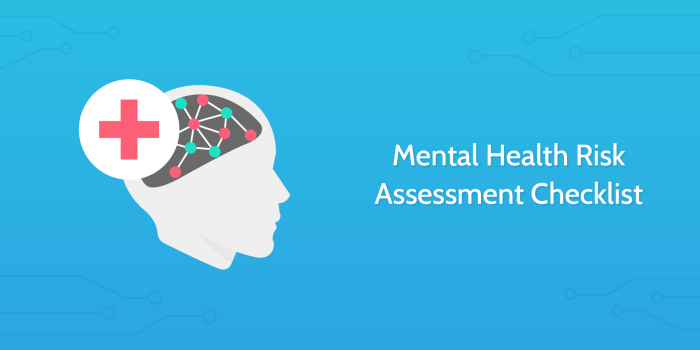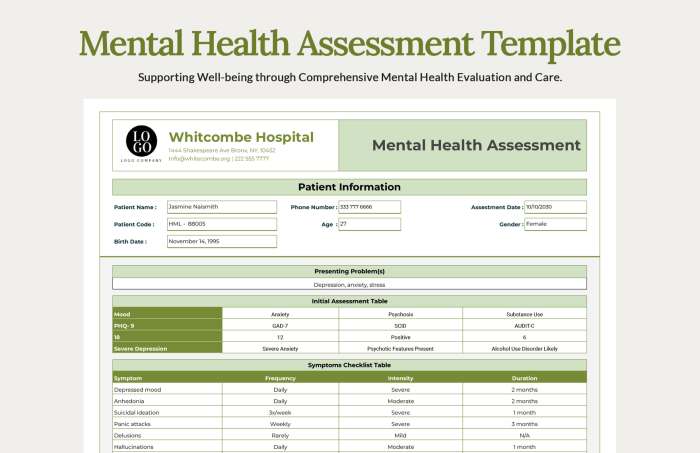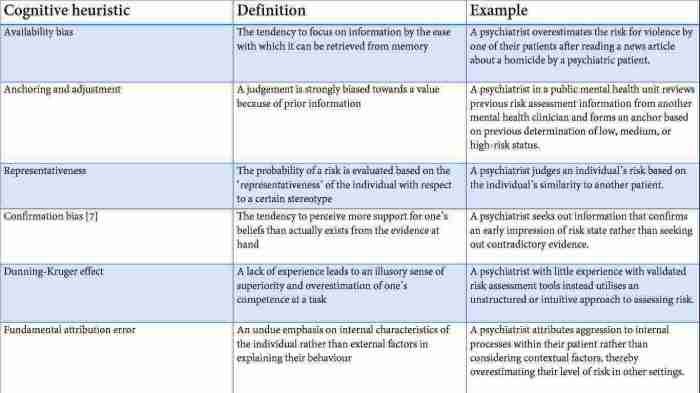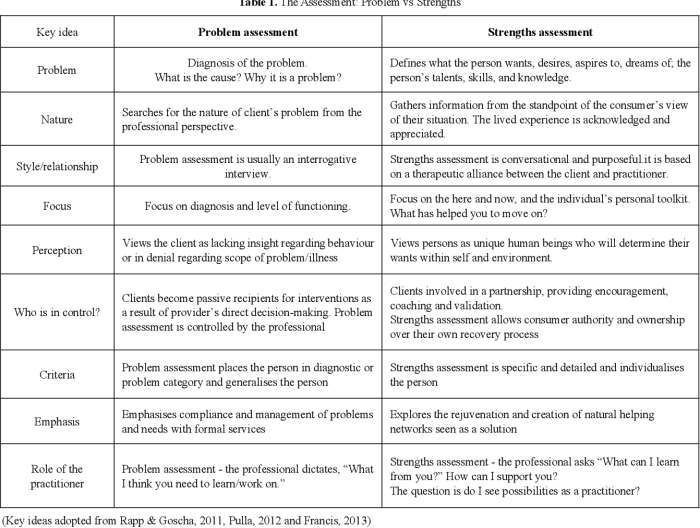Mental health status exams are essential tools for assessing an individual’s psychological well-being. They provide a structured framework for gathering information about a person’s mental state, allowing healthcare professionals to identify potential issues and provide appropriate interventions.
These exams are conducted in a variety of settings, including hospitals, clinics, schools, and workplaces. The purpose of a mental health status exam is to evaluate an individual’s mental health, identify any potential problems, and determine the best course of treatment.
Definition and Purpose

A mental health status exam is a comprehensive assessment used to evaluate an individual’s mental state and overall well-being. It involves a structured evaluation of various aspects of mental health, including mood, behavior, cognition, and overall functioning.The purpose of a mental health status exam is to gain a thorough understanding of an individual’s mental health, identify any potential issues, and guide the development of appropriate interventions or treatment plans.
Significance of Mental Health Status Exams
Mental health status exams play a crucial role in various settings, contributing to the early detection, diagnosis, and management of mental health conditions. They help healthcare professionals:
- Identify mental health conditions:Exams can reveal symptoms indicative of various mental health disorders, such as anxiety, depression, bipolar disorder, and schizophrenia.
- Assess the severity of mental health conditions:The exam helps determine the intensity and impact of mental health issues on an individual’s life, guiding treatment decisions.
- Monitor treatment progress:Regular exams allow healthcare providers to track the effectiveness of treatment interventions and adjust them as needed.
- Promote early intervention:By identifying potential issues early, exams can facilitate timely interventions, improving outcomes and reducing the severity of mental health conditions.
Settings for Mental Health Status Exams
Mental health status exams are conducted in a variety of settings, including:
- Hospitals:In emergency rooms and inpatient settings, exams are essential for evaluating patients with acute mental health crises or suspected mental health conditions.
- Clinics and outpatient settings:Mental health clinics and primary care practices utilize exams for routine assessments, diagnosis, and ongoing management of mental health conditions.
- Schools:Mental health status exams are increasingly used in schools to identify students at risk for mental health issues and provide appropriate support services.
- Workplace settings:Some organizations implement mental health screening programs to identify employees who may be struggling with mental health challenges and offer resources and support.
- Research studies:Exams are essential in research studies investigating the prevalence, course, and treatment of mental health conditions.
Components of a Mental Health Status Exam

A mental health status exam is a comprehensive assessment of an individual’s mental state, covering various aspects of their psychological functioning. This exam helps mental health professionals gather information about a person’s current mental health, identify potential problems, and develop appropriate treatment plans.
Key Components of a Mental Health Status Exam
The key components of a mental health status exam are designed to provide a comprehensive overview of an individual’s mental state. Each component focuses on a specific area of mental functioning, contributing to a complete picture of the individual’s mental health.
A mental health status exam is a crucial step in understanding someone’s well-being, much like how a visit to a beauty house can reveal insights into someone’s personal style and preferences. By assessing an individual’s emotional state, thoughts, and behaviors, a mental health professional can identify potential issues and provide tailored support to promote mental health and overall well-being.
| Component | Description | Purpose | Example Questions |
|---|---|---|---|
| Appearance | This component assesses the individual’s overall physical appearance, including their dress, hygiene, and posture. It provides insights into their self-care and overall well-being. | To evaluate the individual’s self-care and overall well-being. | How would you describe your appearance today? Are you taking care of yourself in terms of hygiene and grooming? |
| Behavior | This component examines the individual’s behavior, including their eye contact, body language, and mannerisms. It helps assess their level of anxiety, agitation, or depression. | To assess the individual’s level of anxiety, agitation, or depression. | How would you describe your mood today? Are you feeling anxious or agitated? Are you having any trouble sleeping or concentrating? |
| Speech | This component focuses on the individual’s speech patterns, including their rate, volume, and fluency. It helps assess their thought processes and cognitive function. | To assess the individual’s thought processes and cognitive function. | How would you describe your speech today? Are you having any trouble speaking clearly or finding the right words? |
| Mood | This component explores the individual’s emotional state, including their overall mood, affect, and emotional range. It helps identify potential mood disorders. | To identify potential mood disorders. | How would you describe your mood today? Are you feeling happy, sad, anxious, or depressed? |
| Thought Content | This component delves into the individual’s thoughts, including their content, organization, and flow. It helps identify potential thought disorders, such as delusions or obsessions. | To identify potential thought disorders, such as delusions or obsessions. | Are you having any unusual thoughts or beliefs? Are you feeling like you are being watched or followed? |
| Thought Process | This component assesses the individual’s ability to think logically and coherently, including their attention, concentration, and memory. It helps identify potential cognitive impairments. | To identify potential cognitive impairments. | Are you having any trouble concentrating or remembering things? |
| Perception | This component examines the individual’s sensory experiences, including their perception of reality, hallucinations, and illusions. It helps identify potential psychotic disorders. | To identify potential psychotic disorders. | Are you experiencing any hallucinations or illusions? Are you seeing or hearing things that are not really there? |
| Cognition | This component assesses the individual’s cognitive abilities, including their memory, attention, concentration, and language skills. It helps identify potential cognitive impairments. | To identify potential cognitive impairments. | Can you tell me the date and time? Can you repeat back a list of three words? |
| Insight | This component explores the individual’s awareness and understanding of their own mental state. It helps assess their ability to recognize and acknowledge their problems. | To assess the individual’s ability to recognize and acknowledge their problems. | Do you think you have a mental health problem? Do you understand the reasons for seeking help? |
| Judgment | This component evaluates the individual’s ability to make sound decisions and understand the consequences of their actions. It helps assess their risk of harm to themselves or others. | To assess the individual’s risk of harm to themselves or others. | What would you do if you found a wallet on the street? What would you do if you were feeling suicidal? |
Methods and Procedures

Mental health status exams can be conducted using a variety of methods, each with its own strengths, limitations, and suitability for different situations. The choice of method often depends on the purpose of the exam, the setting, and the patient’s needs.
Interview
Interviews are the most common method for conducting mental health status exams. They involve a structured conversation between the examiner and the patient, designed to gather information about the patient’s mental health. The interviewer will typically ask questions about the patient’s symptoms, history, and current functioning.
They may also use specific tools and techniques to assess the patient’s mood, thought processes, and behavior.
- Structured Interview:These interviews follow a standardized format with specific questions and prompts. This ensures that all relevant information is gathered and that the exam is conducted in a consistent manner. Examples include the Structured Clinical Interview for DSM-5 (SCID-5) and the Mini-International Neuropsychiatric Interview (MINI).
A mental health status exam can be a powerful tool for understanding someone’s well-being, and it can be particularly helpful when considering factors that may impact self-esteem and body image. For example, a recent study explored the relationship between mental health and shopping habits, finding that individuals struggling with certain conditions might be more likely to engage in impulsive purchases at places like beauty store ulta.
This finding underscores the importance of addressing mental health concerns in a holistic manner, considering not just internal struggles but also external influences that can contribute to overall well-being.
- Semi-structured Interview:These interviews offer more flexibility and allow the interviewer to tailor the questions to the individual patient. This can be particularly helpful in complex cases or when more in-depth information is needed.
- Unstructured Interview:These interviews are more informal and allow the interviewer to follow the patient’s lead. This can be helpful in building rapport and establishing trust, but it may also lead to less comprehensive information being gathered.
Observation
Observation involves watching the patient’s behavior and appearance to gain insights into their mental state. This can be done during the interview, but it can also be conducted in other settings, such as a hospital or a school. The examiner will observe the patient’s physical appearance, body language, speech patterns, and overall behavior.
They may also note any unusual or significant behaviors, such as agitation, restlessness, or withdrawal.
- Direct Observation:This involves directly observing the patient in their natural environment, such as at home or at work.
- Indirect Observation:This involves observing the patient through other sources, such as video recordings or reports from others.
Psychological Tests
Psychological tests are standardized instruments used to assess various aspects of mental health, such as cognitive function, personality, and emotional well-being. They can be used to confirm a diagnosis, monitor progress, or evaluate the effectiveness of treatment.
- Intelligence Tests:These tests measure a person’s cognitive abilities, such as verbal comprehension, reasoning, and problem-solving skills. Examples include the Wechsler Adult Intelligence Scale (WAIS) and the Stanford-Binet Intelligence Scales.
- Personality Tests:These tests assess a person’s personality traits, such as introversion, extroversion, and emotional stability. Examples include the Minnesota Multiphasic Personality Inventory (MMPI) and the NEO Personality Inventory.
- Neuropsychological Tests:These tests assess a person’s cognitive function, such as memory, attention, and executive function. They are often used to evaluate the impact of brain injuries or neurological disorders.
Physical Examination
A physical examination can be helpful in ruling out any underlying medical conditions that may be contributing to the patient’s mental health symptoms. This may include checking the patient’s vital signs, performing a neurological exam, or ordering laboratory tests.
Other Methods
Other methods that can be used to conduct mental health status exams include:
- Review of Records:This involves reviewing the patient’s medical history, including previous diagnoses, treatments, and medications.
- Collateral Information:This involves gathering information from family members, friends, or other individuals who know the patient well.
Interpreting Findings

Interpreting the findings of a mental health status exam is a crucial step in understanding a patient’s mental health. It involves carefully analyzing the information gathered during the exam and considering various factors to arrive at a comprehensive assessment.
Factors to Consider
The interpretation process requires taking into account several key factors that can influence the patient’s mental state. These include:
- Patient’s Background:This includes their personal history, family history, cultural background, and social circumstances. Understanding these aspects can help to contextualize the observed symptoms and behaviors.
- Patient’s History:This includes their medical history, psychiatric history, and any previous treatments they have received. This information can provide insights into the potential causes of their current mental health issues and their response to past interventions.
- Context:The circumstances surrounding the exam, such as the patient’s current life stressors, recent events, and the environment in which the exam is conducted, can also influence the interpretation of findings.
Examples of Interpretation
Here are some examples of how different findings might be interpreted:
- Depressed Mood:If a patient reports feeling depressed and has other symptoms like fatigue, loss of interest, and changes in sleep and appetite, this could indicate a major depressive disorder. However, if the patient is experiencing a recent loss or a stressful life event, the depressed mood could be a normal reaction to these circumstances.
- Anxiety:A patient who exhibits symptoms like excessive worry, restlessness, and difficulty concentrating might be experiencing generalized anxiety disorder. However, if the patient is facing a specific stressful situation, the anxiety could be a situational response.
- Hallucinations:If a patient reports hearing voices or seeing things that others cannot, this could be a symptom of a psychotic disorder like schizophrenia. However, it is important to rule out other potential causes like drug use or medical conditions.
Implications of Findings
The interpretation of findings from a mental health status exam has significant implications for the patient’s treatment and management. Based on the assessment, the mental health professional can:
- Make a diagnosis:This involves identifying the specific mental health condition that best explains the patient’s symptoms.
- Develop a treatment plan:This may involve medication, therapy, or other interventions tailored to the individual patient’s needs.
- Monitor progress:Regular follow-up assessments can track the patient’s response to treatment and adjust the plan as needed.
- Refer to other specialists:In some cases, the patient may need to be referred to other professionals, such as a psychiatrist or a social worker, for specialized care.
Ethical Considerations

Conducting mental health status exams involves navigating a complex landscape of ethical considerations. These considerations are paramount to ensuring the well-being and rights of the individual being assessed. It is crucial to approach these exams with sensitivity, respect, and a commitment to ethical principles.
Confidentiality
Maintaining confidentiality is a cornerstone of ethical practice in mental health. This principle emphasizes the importance of protecting the privacy of individuals who disclose personal and often sensitive information during the assessment.
- It is crucial to ensure that all information gathered during the mental health status exam is kept confidential and shared only with individuals who have a legitimate need to know. This includes maintaining secure records, limiting access to the information, and obtaining informed consent before disclosing any details to third parties.
- Sharing confidential information without explicit consent can have serious consequences, potentially damaging the individual’s trust, reputation, and well-being. This underscores the importance of adhering to strict confidentiality protocols.
Informed Consent
Informed consent is another crucial ethical principle that must be adhered to when conducting mental health status exams. This principle ensures that individuals understand the nature and purpose of the assessment, the potential risks and benefits involved, and their right to decline participation.
- Prior to conducting the assessment, it is essential to provide individuals with clear and concise information about the exam, including its purpose, procedures, and potential outcomes. This allows them to make informed decisions about their participation.
- Obtaining informed consent involves ensuring that individuals understand the information provided, have the opportunity to ask questions, and freely choose whether or not to participate in the assessment. This process should be conducted in a way that respects the individual’s autonomy and decision-making capacity.
Cultural Sensitivity
Cultural sensitivity is an integral part of ethical practice in mental health. It recognizes that individuals come from diverse backgrounds, with varying cultural beliefs, values, and experiences that may influence their understanding of mental health and their willingness to participate in assessments.
- It is essential to approach mental health status exams with an awareness of the individual’s cultural background and to avoid imposing culturally biased interpretations or assessments. This involves being sensitive to language, nonverbal communication, and cultural beliefs that may influence the individual’s understanding of mental health and their responses during the exam.
- Respecting cultural differences and adapting assessment approaches to accommodate diverse cultural perspectives is crucial to ensuring that the exam is conducted in a culturally sensitive and appropriate manner.
Ethical Dilemmas
Conducting mental health status exams can present ethical dilemmas that require careful consideration and ethical decision-making.
- For example, a dilemma may arise when an individual discloses information that suggests they may be a danger to themselves or others. In such situations, the clinician must balance the individual’s right to confidentiality with the responsibility to protect the individual and others from potential harm.
- Another dilemma may arise when an individual’s capacity to provide informed consent is compromised due to their mental health condition. In these situations, the clinician must determine whether it is ethically appropriate to proceed with the assessment, taking into account the individual’s best interests and the potential risks and benefits involved.
A mental health status exam is a crucial part of assessing overall well-being, encompassing emotional, psychological, and social aspects. It’s important to consider the impact of external factors on mental health, such as the pursuit of self-care practices like those found in the beauty master guide, which emphasizes healthy routines and positive self-image.
By recognizing the connection between these areas, we can create a more holistic approach to mental health and well-being.
Applications and Use Cases: Mental Health Status Exam

Mental health status exams are valuable tools employed across various fields to assess and monitor mental well-being. Their applications extend beyond clinical settings, proving beneficial in education, social services, and research endeavors.
Healthcare
Mental health status exams are fundamental in healthcare settings, serving as a cornerstone for diagnosing and managing mental health conditions. They enable healthcare professionals to gather essential information about a patient’s mental state, including symptoms, history, and current functioning.
- Diagnosis:Mental health status exams aid in identifying potential mental health disorders by evaluating symptoms, behaviors, and cognitive functioning. They help differentiate between various conditions, leading to accurate diagnoses and appropriate treatment plans.
- Treatment Planning:The results of mental health status exams inform treatment planning, allowing healthcare providers to tailor interventions to individual needs. For example, a patient with severe anxiety might require different treatment approaches compared to someone with mild depression.
- Monitoring Progress:Regular mental health status exams are crucial for monitoring treatment progress and adjusting interventions as needed. They help track changes in symptoms, mood, and overall well-being, ensuring that treatment remains effective.
- Identifying Risk Factors:These exams can also identify risk factors for mental health issues, such as family history, stressful life events, or substance abuse. This information helps healthcare providers implement preventative measures and early interventions.
Education
Mental health status exams play a crucial role in educational settings, promoting the well-being of students and supporting their academic success.
- Early Intervention:Mental health status exams can identify students struggling with mental health challenges early on, enabling educators and school counselors to provide timely support and interventions. Early identification and intervention can prevent academic difficulties and promote overall well-being.
- Academic Performance:Mental health issues can significantly impact academic performance. By identifying students at risk, educators can implement strategies to address these issues and support their academic progress. This might involve providing accommodations, referrals to mental health professionals, or creating a supportive classroom environment.
- School Climate:Mental health status exams can also provide insights into the overall school climate and identify areas for improvement. This information can inform initiatives to promote positive mental health within the school community.
Social Services
Mental health status exams are essential tools for social service agencies, assisting in the assessment and support of individuals facing various challenges.
- Needs Assessment:These exams help social service agencies assess the mental health needs of individuals seeking assistance. This information informs the development of tailored support plans and interventions.
- Case Management:Mental health status exams facilitate case management by providing a comprehensive understanding of an individual’s mental health status and needs. This information guides social workers in coordinating services, referrals, and ongoing support.
- Community Outreach:Mental health status exams can be used in community outreach programs to identify individuals at risk of mental health issues and provide early intervention services. This approach helps promote mental health awareness and reduce stigma surrounding mental illness.
Research
Mental health status exams are invaluable in research, enabling researchers to study mental health conditions, evaluate treatment effectiveness, and identify risk factors.
- Epidemiological Studies:These exams help researchers understand the prevalence and distribution of mental health disorders within a population. This information is crucial for developing public health policies and interventions.
- Treatment Efficacy Trials:Mental health status exams are used to assess the effectiveness of various treatments for mental health conditions. They help determine whether a particular intervention improves symptoms, reduces disability, and enhances overall well-being.
- Risk Factor Research:Mental health status exams can identify risk factors associated with developing mental health issues. This information helps researchers understand the causes of these conditions and develop targeted prevention strategies.
Concluding Remarks

Mental health status exams are invaluable in promoting mental well-being. By providing a standardized method for assessing mental health, these exams empower individuals to seek help and support when needed. The information gathered through these exams allows healthcare professionals to develop personalized treatment plans that address the unique needs of each patient.
Top FAQs
What is the difference between a mental health status exam and a psychological evaluation?
A mental health status exam is a brief screening tool that assesses basic mental health functioning, while a psychological evaluation is a more comprehensive assessment that delves into specific areas of concern, such as personality, intelligence, or cognitive abilities.
Who can conduct a mental health status exam?
Mental health status exams can be conducted by various professionals, including psychiatrists, psychologists, social workers, and nurses, depending on the setting and purpose of the exam.
How long does a mental health status exam take?
The duration of a mental health status exam varies depending on its scope and complexity. A basic exam may take 15-30 minutes, while a more comprehensive assessment could take longer.
Is a mental health status exam confidential?
Yes, mental health status exams are confidential and protected by HIPAA privacy regulations. Information shared during the exam is typically only shared with authorized individuals involved in the patient’s care.